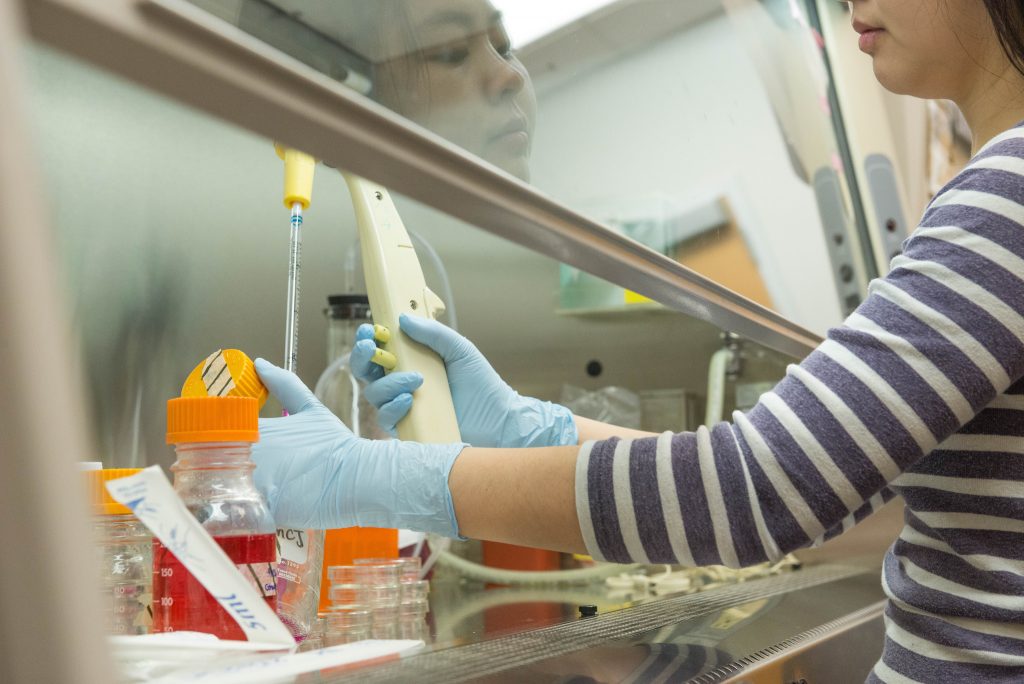Published on

Graduate student Yuleum Song prepares cells for viral infection in the BL-2 hood. | Image by Jennifer Lu, Bond LSC
By Madelyne Maag | Bond Life Sciences Center
Viruses can be nasty things and scientists have to take precautions.
You might think of researchers in floor-length lab coats, safety goggles, and plastic gloves or even the more extreme look of bulky, yellow hazmat suits similar to what Jim Hopper wear in Stranger Things. But, depending on the type of viruses being handled, these stereotypes aren’t quite the truth.
For labs like that of Marc Johnson in Bond LSC, safety comes from the incomplete nature of the HIV viruses they study. The viruses in Johnson’s lab are defective, meaning they cannot reproduce themselves. It doesn’t mean the virus is completely safe to handle. If it were to come into contact with another living being it would only infect the cells exposed to the virus and could not expand further. With defective strains of HIV, the virus can be grown at biosafety level two.
This level two is one of four levels of biosafety that are used to define how a lab might be physically set up and how its researchers are equipped in order to contain a virus. The levels act as more of a scale than a concrete definition of the lab since the type of virus being handled by a lab can vary.
Johnson, a professor of Molecular Microbiology and Immunology, says that his lab teeters between BSL-2 and BSL-3 depending on what type of virus they are working with.
“Our lab is classified as a BSL-2 (Biosafety Level 2) because we work with pathogens that have a low chance of spreading and a low chance of doing significant damage if they do spread,” said Dr. Johnson. “This simply means that our lab is shut off from anyone outside the lab who might try to come in outside of business hours. We also equip our staff with safety goggles, and gloves while they work with a virus under a Laminar Flow Hood to keep the air sterile.”
The major difference between levels like BSL-2 and BSL-3 often comes down to the type of virus being handled, whether it be something like HIV or a more lethal infection like SARS. The Laboratory for Infectious Disease Research is one of the only facilities on the MU campus, that can be classified as a level three. Because the lab handles airborne viruses, they take extra precautions to regulate air and waste coming out of the facility.
The highest level of biosafety can be identified as BSL4, which typically handles deadly viruses such as Ebola that could cause significant harm if it spread. This is where the terrifying and bulky hazmat suits come into play. The virus being handled in a BSL-4 lab comes with a high risk of researchers being infected if the proper steps are not taken to properly handle or contain the virus.
There are no BSL-4 laboratories in Columbia. In fact, one of the nearest labs won’t be opening its doors until 2022 in Manhattan, Kansas. These levels of safety are simply put in place to protect those who wish to study a virus and further medical research for the rest of the world.
The different levels of Biosafety might seem frightening to some, but there is nothing really to fear. These precautions are put in places just as signs that remind us to wash our hands after using the restroom. They are ways to prevent the contamination and spread of viruses and disease. MU Researchers don’t just have these precautions in place to protect everyone around them. They also have these precautions in place so that viruses like HIV can be better understood and treated by medical professionals around the world.